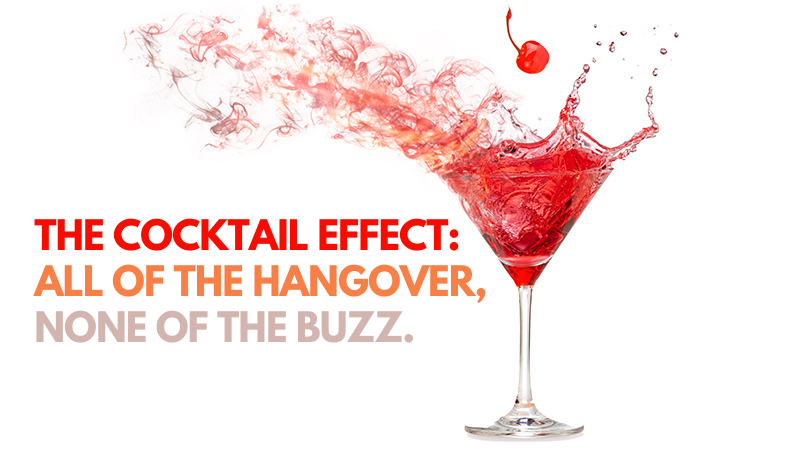No person is an island, and neither are hazardous chemicals. We are all being exposed to a virtual “cocktail” of hundreds – if not thousands – of potentially harmful substances every day. The cocktail effect needs to be considered when regulating substances of concern and calculating limit values.
There is one thing in the discussions on effects and regulation of chemicals that makes you want to put your hands over your ears, shut your eyes, and maybe even go “LA-LA-LA-LA-LA!” for a while. Being reminded of the cocktail effect can feel overwhelming – just when you thought you were starting to get a grip on the chemical issue.
The equally sad and infuriating truth is that we are all exposed to a large but unknown number of unknown chemicals. And the resulting effects of the combination of all these substances is more or less impossible to predict; there are simply too many variables.
The combination could be greater than the sum
This fascinating scientific field is called mixture toxicity. We know that there are cases where the combination of different chemicals results in a stronger or different response than the sum of each of the individual chemicals.
Still, this has rarely been considered in regulation. Risk assessment of chemicals treats each individual chemical as if it was the only one in an otherwise completely pure universe. But it’s not. It’s one among hundreds, or even thousands.
Not taking the cocktail effect into account is like saying: “If I drink no more than four beers, I will be just fine tomorrow.” Then you drink four beers AND three glasses of wine, two whiskeys and two gin and tonics, and wake up the next morning – very surprised to learn that you have a hangover: “But I only had four beers…”
“Risk assessment of chemicals treats each individual chemical as if it was the only one in an otherwise completely pure universe”
Our friends at ChemTRUST just published a really nice report that explains all this in a clear way – a recommended read if you want to get a good understanding of the issue.
How do we regulate the unknown?
We are all aware that when we take medicines, we need to consider what other drugs we take as well, to avoid unwanted mixture effects. But when it comes to chemicals, we are exposed to so many more than those we deliberately ingest.
We breath in chemicals released from the electronics we use, eat chemicals released from food packages, absorb chemicals from our clothes, and so on. And this constant exposure to a wide range of different substances affects us.
“We have only started scratching the surface when it comes to effects of chemical mixtures”
A recent study showed that infants – whose mothers had a typical mix of EDCs (Endocrine Disrupting Chemicals) from different sources in their urine pre-birth – gain weight slower, compared to infants whose mothers had lower levels of EDCs.
Another study found correlations between later brain development in children and chemical mixtures found in their mothers’ test samples collected during pregnancy.
These excellent studies aside, we have only started scratching the surface when it comes to effects of chemical mixtures. So where we even begin to regulate them? Well, at long last – and in accordance with the Chemicals Strategy for Sustainability – the Commission has promised to do something about the cocktail effect. The proposal at hand is to introduce something called Mixture Assessment Factor, or MAF for short.
The concept is very simple: Whenever you calculate risks or limit values of a certain chemical, you divide the result with the Mixture Assessement Factor, as an acknowledgement of all the unknown chemicals this chemical will interfere with – in nature or in a person. The idea is to lower the exposure of each individual chemical and “make room” for unknown exposure.
Let’s take artificial preservatives as an example, present in many foods, beverages and hygiene products. Let’s also say that the safe limit level for preservatives is 4 grams per kilogram, which means that a product containing that much is technically okay. But that doesn’t take into account the many other sources of preservatives that we consume and use every day. Dividing the limit level of individual products with a MAF factor of – say – 100 would bring the safe limit level for any given product down to 0.04 grams per kilogram, and help lower our total exposure to preservatives significantly.
Don’t dilute the factor!
Right now, the discussions revolve around how big the MAF should be, whether it should be the same or different for human health and the environment, and if it should vary between different kinds of chemicals.
ChemSec’s position is that we don’t see any reason for using different MAFs. After all, human beings are part of the environment, and the whole point of accounting for the unknown is that this consideration should not be limited to certain chemicals.
We, as well as our NGO colleagues, propose to use the Mixture Assessment Factor 100, or 10 times 10. The first 10 is to account for the unknown number of chemicals, and the second one to account for the unknown sources of exposure.
“We hope that the Commission displays courage, determination and speed in introducing a MAF large enough to actually provide a better protection for human health and the environment”
We hope that the Commission displays courage, determination and speed in introducing a MAF large enough to actually provide a better protection for human health and the environment. The chemical cocktail effect is the one hangover that can’t be cured with a pill and a greasy pizza.





